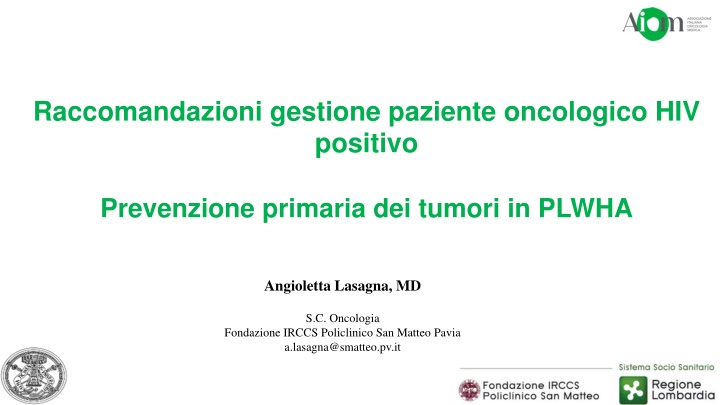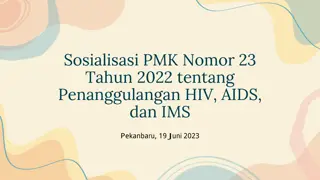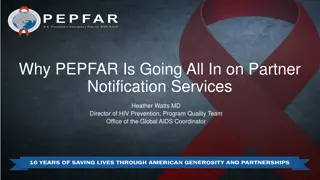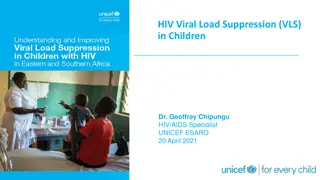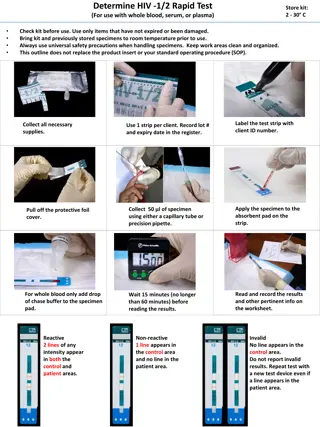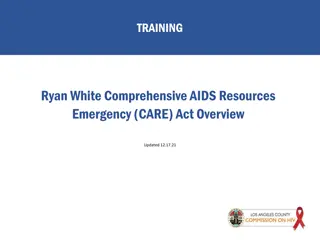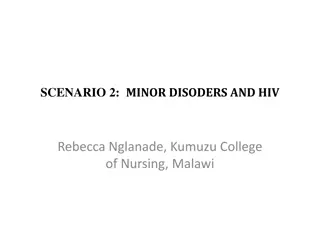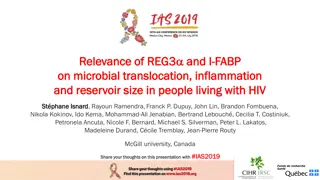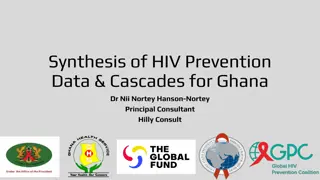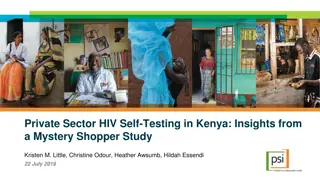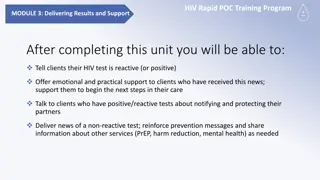Raccomandazioni gestione paziente oncologico HIV positivo
People living with HIV are at high risk for developing various cancers. This includes both AIDS-defining cancers and non-AIDS-defining cancers. Antiretroviral therapy plays a crucial role in reducing cancer incidence and risk among PLWHA. Studies suggest that immediate initiation of combination antiretroviral therapy can significantly decrease cancer risk in this population. Special considerations and strategies need to be implemented for the prevention of tumors in oncology patients with HIV.
Download Presentation

Please find below an Image/Link to download the presentation.
The content on the website is provided AS IS for your information and personal use only. It may not be sold, licensed, or shared on other websites without obtaining consent from the author.If you encounter any issues during the download, it is possible that the publisher has removed the file from their server.
You are allowed to download the files provided on this website for personal or commercial use, subject to the condition that they are used lawfully. All files are the property of their respective owners.
The content on the website is provided AS IS for your information and personal use only. It may not be sold, licensed, or shared on other websites without obtaining consent from the author.
E N D
Presentation Transcript
Raccomandazioni gestione paziente oncologico HIV positivo Prevenzione primaria dei tumori in PLWHA Angioletta Lasagna, MD S.C. Oncologia Fondazione IRCCS Policlinico San Matteo Pavia a.lasagna@smatteo.pv.it
Disclosures Honoraria:Novartis, Gilead Advisory Board: GSK
Background (1) People living with HIV (PLWHA) have high risk of developing acquired immune (AIDS)-defining cancers (Kaposi's sarcoma, non-Hodgkin lymphoma, and cervical cancer) deficiency syndrome With antiretroviral therapy (HAART) worldwide, however, there has been a rise in incident non-AIDS-defining cancers (NADCs) among PLWHA developing countries and this trend is projected to persist in the future the massive introduction of highly active in both developed and Yuan T, et al. EClinicalMedicine. 2022
Background (2) The observed in a range of subgroup analyses by country income levels, WHO regions, sex, and HIV risk groups, and predominant among those with AIDS increased risk pattern is consistently tend to be more Yuan T, et al. EClinicalMedicine. 2022
PICO Is HAART a risk factor for a diminished incidence of cancer? P = PLWHA I = HAART C = between Pre and post- HAART / between PLWHA and general population O = incidence of cancer (AIDS and non-AIDS-defining cancers)
HAART & START In the Strategic Timing of Antiretroviral Treatment (START) study, immediate combination antiretroviral therapy (cART) initiation reduced cancer risk by 64% Adjustment for latest HIV RNA level had little impact on the protective effect of immediate cART on infection-related cancer Adjustment for latest HIV RNA level, but not for CD4 cell count or cancer risk factors, attenuated the effect of immediate cART on infection-unrelated cancer Borges H, et al. Clin Infect Dis. 2016
Kaposi Sarcoma & HAART FIRST AUTHO R, YEAR Name of the study Type of study Num of Pts Type of comparison (and period) Outcome Limitations Lacombe JM, 2013 Retrospective cohort study within the French Hospital Database on HIV Agence Nationale de Recherches sur le SIDA et les hepatites virales FHDH-ANRS CO4 Retrospective data Kaposi sarcoma (N=1811) To compare risk for Kaposi sarcoma by time on cART and CD4 reconstitution [during 1996 2009] Months 1 3 on cART accounted for 1.6 additional Kaposi sarcoma cases per 1000 person-years, after adjustment for CD4 cell count and HIV-RNA level - -// Biggar RJ, 2007 HIV/AIDS Cancer Match Study 325,516 adults with AIDS To investigate the association between cancer risk and CD4 cell count among AIDS people pre [1990-1995] and post HAART [1996-2002] The incidence of Kaposi sarcoma was lower in 1996-2002 (334.6 cases per 100,000 person- years) than in 1990-1995 (1838.9 cases per 100,000 person-years) In 1996-2002, for each decline in CD4 cell count of 50 cells per microliter of blood, increased risks were found for Kaposi sarcoma (HR = 1.40, 95%CI = 1.33 to 1.50) Incidence rates for KS and lymphomas were highest in the first 6 months after ART initiation (P < .001) and plateaued thereafter, while incidence rates for all other cancers combined increased from 416 to 615 cases per 100 000 person-years from 1 to 10 years after ART initiation (average 7% increase per year; 95% confidence interval, 2% 13%) -Timing of CD4 measure Yanik EL, 2013 Dynamic observational cohort >25 000 HIV- infected adults in routine care at 8 USA center from 1995 to the 2013 To evaluate the incidence and timing of cancer diagnoses among patients initiating ART [between 1996 and 2011] -The study does not account for changes or discontinuations in ART after initiation, nor does it account for differences in the immunologic or virologic response to ART - Lacombe JM, et al. AIDS. 2013; Biggar RJ, et al. J Natl Cancer Inst. 2007; Yanik EL, et al. Clin Infect Dis. 2013
Pre-HAART vs Post-HAART Several papers compared the incidence of cancer in the pre-HAART and post-HAART phase with evidence of: a decline in AIDS-related cancers (Kaposi Sarcoma and NHL in particular) a gradual increase in non-AIDS-related cancers
Pre-HAART vs Post-HAART (selection) Crum- Cianflone N, 2009 Prospective, observational study To compare cancer incidence among HIV- infected during 4 periods in the USA: early pre- (1984-1990), late pre- (1991-1995), early post- (1996-2000), and late post (2001-2006) HAART eras. ADC rates increased between the early and late pre-HAART eras (7.6 and 14.2 cases per 1000 person years) and have since declined from 5.4 to 2.7 in the early and late HAART eras, respectively (p<0.001). Rates of NADCs have risen over the 4 periods (2.9, 2.8, 4.2, 6.7, p=0.0004). During the late HAART era, 71% of cancers were NADCs. No significant increase in the incidence of NADCs in the pre-HAART era (SIR, 0.95; 95% CI, 0.58 to 1.47) Increase in the incidence in both the early HAART and established HAART eras (SIR, 2.05; 95% CI, 1.51 to 2.72; and SIR, 2.49; 95% CI, 2.00 to 3.07, respectively) Anal cancer: SIR=122.0; 95% CI, 88.6 to 163.7. The SIRs did not differ significantly between the time periods Liver cancer: SIR=5.13; 95% CI, 1.88 to 11.16. The significantly increased incidence occurred only in the established HAART era Lung cancer:SIR=1.95; 95% CI, 1.16 to 3.09. This increase was confined to the early HAART and established HAART eras (SIR=3.10; and SIR=2.37) - No evaluation of the other risk factors TACC NHS 4,566 PLWHA Powles T, 2009 To compare cancer incidence among HIV- infected during 3 periods: the pre-HAART era (1983 to 1995), the early HAART era (1996 to 2001), and the established HAART era (2002 to 2007). -Lack of comprehensive data on the detection of known oncogenic viruses - Prospective cohort study 11,112 PLWHA Seaberg EC, 2010 Multicent er AIDS Cohort Study (MACS) Prospective observational study To compare cancer incidence among HIV- infected and HIV-uninfected participants and pre/post HAART era (pre-HAART era [1984-1995] and the HAART era [1996- 2007]) in the USA The incidence of KS and NHL declined (IRR, 0.13 and 0.23, respectively), the incidence of anal cancer increased (IRR, 5.84), and the incidence of HL remained statistically unchanged (IRR, 0.75) from the pre-HAART to the HAART era. - Small number of individual NADCs; - No generalization to women or to other racial and HIV risk groups; - No evaluation of the other risk factors 6,972 men who reported having had sex with men (MSM) Crum-Cianflone N, et al. AIDS. 2009; Powles T, et al. J Clin Oncol. 2009; Seaberg EC, et al. Cancer. 2010
PLWHA and HAART vs general population Although NADCs incidence is increased when compared with the general population, the use of more effective and efficient HAART therapy is protective against the development of NADCs in PLWHA through immune reconstitution Chiu et al reported that a nadir CD4 level > 200 cells/mm3 was protective against NADC development Previous research has suggested that a higher percentage time with undetectable HIV RNA was protective against the development of NADCs, highlighting the importance of the host immune system in HIV clearance and NADC development The reduction of NADCs is less evident in viral related cancer suggesting that virus related inflammation may limit HAART effects Chiu CG, et al. BMC Cancer 2017
HAART & non-AIDS-defining cancers (selection) Zlotorzyn ska M, 2016 Registry-based retrospective cohort study To investigate the cancer incidence and mortality among PLWHA incarcerated in Georgia, USA [between 1998 and 2009] The incidence of viral-associated NADCs was significantly higher among PLWH versus those without HIV infection (standardized incidence ratio=6.1, 95% CI 3.0 to 11.7, p<0.001). The risk for AIDS-defining cancers and NADC in the male population with AIDS was significantly higher than that in the general population (SIR=27.74 and 1.87,respectively) Most virus-related NADC occurred at elevated rates among PLWA: anal cancer (SIR=33.02 in men and 11.21 in women), liver (SIR=4.35 in men and 4.84 in women), vulva and vagina (SIR=6.78 in women) and Hodgkin lymphoma (SIR=5.84 in men and 2.71 in women). Lung (SIR=2.24 in men and 2.60 in women) and central nervous system (SIR=1.92 in men and 3.48 in women) SIR of Kaposi s sarcoma was markedly increased (620.89, 401.69 916.59), followed by that of NHL (21.51, 17.44 26.24), and cervical cancer (7.5, 3.00 15.45). The risk was significantly elevated for virus- related NADCs, including HPV-related head and neck cancer (2.97,1.48 5.32), anal cancer (69.52, 41.84 108.57), liver cancer (2.53 4.27), and HL (20.65, 8.27 42.55). Risks were also significantly elevated in: lung (1.91, 1.35 2.63), penis (16.97, 1.94 61.28), prostate (1.79, 1.16 2.64) PLWHA with non-optimal ART adherence had significantly higher SIR for some NADCs and ADCs, except for cervical cancer, than those with optimal ART adherence. This was observed for each ADC and virus-related NADCs such as anal cancer (SIR: 0.33, 95% CI 0.11 0.90) and liver cancer (0.47, 0.44 0.81) - 848 PLWHA -Possible ascertainment bias - No evaluation of other risk factors - As an ecological study, this study has low analytical capacity, being essentially descriptive Tanaka LF, 2018 Registry-based retrospective cohort study 2074 PLWA cancer To assess the risk for cancer in people with AIDS (PWA) in comparison with the general population in S o Paulo (Brazil), [between 1997 and 2012] - Lee SO, 2022 Retrospective population based analysis To investigate the cancer incidence in Korea during HAART era compared to the general population [between 2000-2014] -Smoking, alcohol use, and the prevalence of oncogenic viral infection, were not considered - 11,737 PLWHA Zlotorzynska M, et al. BMJ Open. 2016; Tanaka LF, et al. Eur J Cancer Prev. 2018; Lee SO, et al. Sci Rep. 2022
HIV-1 and/or its viral proteins accelerate oncovirus- mediated tumorigenesis Proulx J, et al. Biomedicines. 2022
Coinfection HCV/HBV and HIV (1) Several studies have shown an increased risk of NADC in patients co-infected with HBV and/or HCV Darvishia n M, 2021 British Columbia Hepatitis Testers Cohort (BC-HTC) Retrospective cohort study 658,697 individuals with cancer (1407 colorectal, 1294 liver, and 489 pancreatic cancers) To assess the risk of colorectal, liver, and pancreatic cancers among HCV, HBV, and HIV mono and co/triple- infected individuals compared to individuals who tested negative for these infections The risk of colorectal cancer was significantly higher among HCV/HIV co-infected (HR 2.38; 95% CI 1.31 4.34) individuals HCV/HIV [HR 44.62 (25.77 77.26)] and HBV/HIV [61.22 (29.38 127.579] co-infection, as well as triple infection, were also significantly associated with an elevated risk of liver cancer - Information on other factors, such as HIV ART, HBV treatment, and smoking status, was not available Meijide H, 2017 Retrospective cohort study 185 patients (117 HIV and 68 HIV/HCV) To evaluate incidence and mortality of cancers among HIV/HCV coinfected compared to HIV monoinfected The incidence rate of NADC in HIV/HCV- coinfected patients was 415.0 (SIR=3.4), significantly higher than in monoinfected (377.3; SIR=1.8). After adjustments, HIV/HCV-coinfected patients had a higher cumulative incidence of NADC than HIV-monoinfected (aHR=1.80), even when excluding HCC (aHR=1.26) - - retrospective design - no data about tobacco and alcohol consumption Darvishian M, et al. Ther Adv Med Oncol. 2021; Meijide H, et al. AIDS. 2017
Coinfection HCV/HBV and HIV (2) Other studies do not show a statistically significant difference in increased risk of developing neoplasms Mocroft A, 2020 EuroSIDA Cohort Prospective, observational cohort To compare incidence rates between HCV groups for non acquired immunodeficiency virus defining malignancy (NADM; excluding HCC) 1)HCV antibody negative; 2)HCV antibody positive, HCV RNA negative, and untreated (spontaneous clearers); 3)HCV antibody positive, HCV RNA positive, and untreated (chronic infections); 4)HCV antibody positive, HCV RNA negative, and treated (successfully treated with any licensed HCV therapy; cured); and 5)HCV antibody positive, HCV RNA positive, and treated (treatment failure). After adjustment, there were no differences in incidence rates of NADC 919 HIV/HCV -No evaluation of SVR -No evaluation of other risk factors Mocroft A, et al. Open Forum Infect Dis. 2020
HIV and DAA Corm a- G me z A, 2021 - Multisite prospective cohort study 1035 HCV- infected patients were included, 667 (64%) coinfected with HIV To assess the impact of HIV infection on the risk of developing HCC in patients infected HCV who achieve SVR with DAA In the multivariable analysis, HIV coinfection was associated with a lower adjusted risk of developing HCC (sHR = 0.27, 95%CI: .08 .90; P = .034 when achieved SVR with DAA -Short follow up (median follow-up time after SVR was 37 months) -Concomitant causes of liver diseases, such as NAFLD have not been analyzed in this study This study suggests that HIV/HCV-coinfected patients with advanced fibrosis who achieve SVR with DAA- based regimens have a lower risk of developing subsequently de novo HCC than HCV-monoinfected patients Despite HIV/HCV-coinfected patients showing data of more advanced liver disease at baseline, such as higher liver stiffness, MELD and FIB-4 scores or lower platelet counts, the probability of developing HCC was lesser in this subset This finding continued to be observed after extensive control of potential confounders Corma-G mez A, et al. AIDS. 2021
Smoking and alcohol in PLWHA The prevalence of smoking among PLWHA in Western countries has been considerably higher than in the general population, ranging from 40% to 70% Studies agree in showing an increased risk of smoke-related cancers in smokers, and also in former smokers Shep herd L, 2019 [62] The D:A:D Study Prospective cohort study 35442 PLWHA (49% were current smokers, 21% were ex- smokers, and 30% had never smoked) To evaluate the cancer incidence according to the smoking status in PLWHA Lung cancer incidence (n = 271) was elevated <1 year after cessation (aIRR, 19.08 [95% CI, 8.10-44.95]) and remained 8-fold higher 5 years after smoking cessation (aIRR, 8.69 [95% CI, 3.40- 22.18]). Incidence of other smoking-related cancers (n = 622) was elevated in the first year after cessation (aIRR, 2.06 [95% CI, 1.42-2.99]) and declined to a level similar to nonsmokers thereafter - No data about the other risk factors HIV-positive patients should be screened for smoking, and current smokers should be enrolled in smoking cessation programs as a part of care in HIV-positive patients Shepherd L, et al. Clin Infect Dis. 2019
